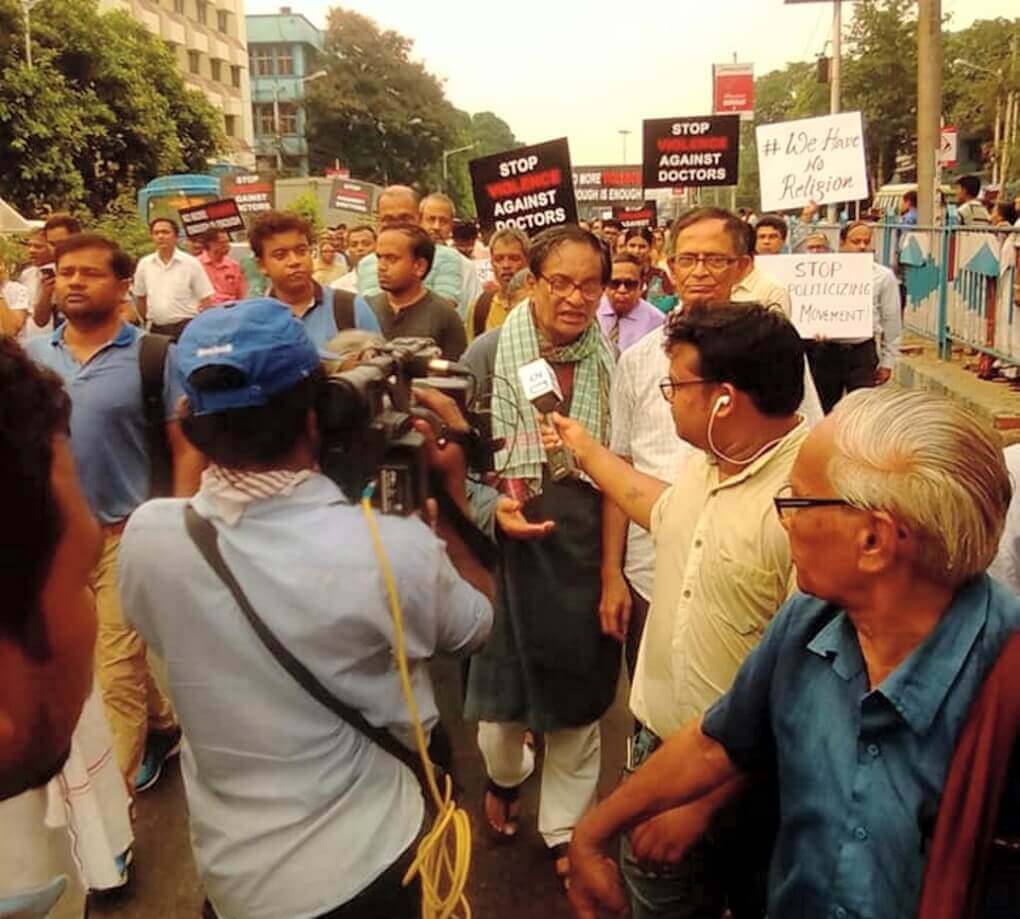
AFTER a week of agitation, protesting junior doctors of Kolkata finally had an opportunity on 17 June to negotiate directly with the Chief Minister. The discussion between the representatives of protesting doctors and the state government was televised live and it ended on a positive note with the doctors placing their immediate demands and the government coming up with its set of announcements and assurances. As the protesting doctors go back to work, the government will be under watch as to how seriously it now walks the talk. The people of West Bengal have heaved a sigh of relief and are hoping to see some ‘restoration of normalcy’ on the crucial healthcare front. The protesting doctors should also be thanked for the fact that in the volatile and heavily charged situation of West Bengal they managed to maintain their unity, stick to their basic demands, and rebuff the BJP’s obnoxious attempts to communalise the incident.
The doctors’ agitation started when a fellow doctor in Kolkata’s NRS Medical College and Hospital got badly injured in a brutal attack by a patient party following the death of an elderly patient. There are now different versions as to what exactly had happened and how, but what clearly aggravated the situation was the Chief Minister’s insensitive response. A prompt intervention by the CM condemning the attack, visiting the injured doctor and assuring doctors and other hospital staff about their security could have perhaps helped defuse the situation right at the outset. But the CM chose to do the opposite and the protests then predictably became wider and louder with senior doctors joining the protests and even announcing their mass resignation and solidarity actions spreading across the country. It is really unfortunate that it took a weeklong agitation and televised negotiations for the CM to finally agree to visit the injured doctor! There is something seriously wrong when elected representatives of people and heads of administration display such limitless arrogance and utter lack of sensitivity.
The specific incident that triggered the doctors’ agitation may perhaps have been partially addressed through the negotiations between the doctors and the state government. Doctors and other health workers must be saved from such attacks, they have every right to have a peaceful and dignified working environment and in case of any violation they must have effective remedy and assured access to justice. The systematic weakening of institutions and politicisation of administration clearly creates an adverse environment, in place of prompt institutional redressal of grievances we have to face a situation of politically patronised mass hooliganism. This problem of insecurity of doctors may have assumed particularly major proportions in West Bengal in recent years, but even a cursory glance at reports from other states will tell us that the problem is quite common in many parts of the country. And cases of ruling party leaders and elected representatives assaulting doctors and health workers have also been fairly widespread.
But the attacks on doctors are not just a law and order problem and cannot be resolved merely by strengthening security measures in hospitals. The insecurity of doctors stems from the explosive crisis of healthcare and the extremely difficult working conditions in which junior doctors find themselves in most government hospitals which are terribly overcrowded, understaffed and under-equipped. Only a much bigger allocation for health budget and enhanced emphasis on improving the quality of healthcare for common people can bring about a basic improvement in the situation and minimise the chances of doctor-patient friction and attacks on doctors. There is also the question of sensitising doctors to the complex and challenging social reality of India. In India, administrators, police officials and doctors, all of whom have to interact with large numbers of people on an everyday basis, have to be particularly sensitised to deal with the people in a democratic manner. The motto of ‘serving the people’ gets lost in real life as various social privileges, economic power and the deeply ingrained sense of hierarchy tend to determine the conduct of people placed in positions of power.

The issue of security and dignity of doctors has been central to many agitations of doctors in recent past. Various associations of doctors have often responded in solidarity and doctors have taken principled positions as a collective body of health professionals. But this collective response should address not just cases of doctor-patient or doctor-public antagonism but also cases of doctors facing the wrath of a hostile administration like in the events of Dr Binayak Sen in Chhattisgarh or Dr Kafeel Khan in Uttar Pradesh, or doctors and medical students being harassed by fellow doctors and students as in the tragic and telling case of Dr Payal Tadvi. At the same time, doctors’ movement should also concern itself with the broader and basic issues of public health. To take just one stark example, the Kolkata doctors’ agitation with the attendant countrywide attention and solidarity has coincided with a public health emergency in Bihar with scores of children dying daily in encephalitis which has hardly got the administrative and media attention that it deserves.
A powerful people’s awakening and assertion to realise the goal of ‘Health for all’, a guarantee of universal healthcare instead of fancy insurance schemes that only promote privatisation and commercialisation of the healthcare sector, is the need of the hour. Doctors, concerned citizens and common people should all join hands and come forward in this direction.
Charu Bhawan, U-90, Shakarpur, Delhi 110092
Phone: +91-11-42785864 | Fax:+91-11-42785864 | +91 9717274961
E-mail: info@cpiml.org




